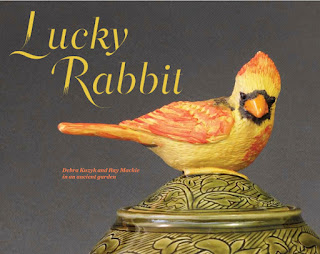First, a shout-out: my heart-felt thanks go to "follower" David Hayashida of King's Point Pottery. When I doubted whether I should continue to blog he persuaded me to continue. "It was hard to find time to blog," I complained. Besides, I didn't need more work. I was already afraid to answer the phone. Lesson time: he countered "you should do it so that you have even more interesting projects to turn down." Damn it but the boy was right. (Don't get me wrong; David is close to my age.)
This sculpture by David Hayashida is composed of teapots, the negative space in the interior describe the nuclear symbol warning symbol.
Since the start of 2012, I have said no to two mainland galleries waving plane tickets under my nose, passed on magazine assignments to younger, hungrier writers and…well, let's just say I have some projects in the works that I'm very excited about. So my motto has become "be an explainer not a complainer".
February and March are traditionally two of my busiest months on the work calendar. City, provincial and federal grant proposals need to be written for myself and for clients. March 31st is the end of fiscal year for many nonprofit and cultural groups and that means that grant monies need to be spent or returned. So there is a spending frenzy. All of sudden that brochure that they thought was unaffordable needs to be written NOW!
Ironically, the upswing in my work outside of the province was the result of a strategic writing workshop I taught in downtown St. John's at the Anna Templeton Centre at the start of 2009. Almost as far back as I can remember I have taught versions of this workshop: how to write an artist statement, how to write point of purchase literature, how to write a press release, how to write an exhibition proposal. Basically, it boils down to "how to write to make things happen."
For the 2009 workshop I needed to update my course material and I thought, "this is great, I have licence to contact gallery directors, curators and funding agencies and find out what their pet peeves are, what they are interested in seeing in exhibition and grant proposals." To be honest, it was a lot of fun and made for some juicy lecture material. And it was very, very useful to my students and myself. I ended up with two exhibitions, a speaking engagement and three grants–none of which I planned on when I picked up the telephone to do the research for the workshop. In turn, those projects have sparked more professional activity and cherished relationships.










